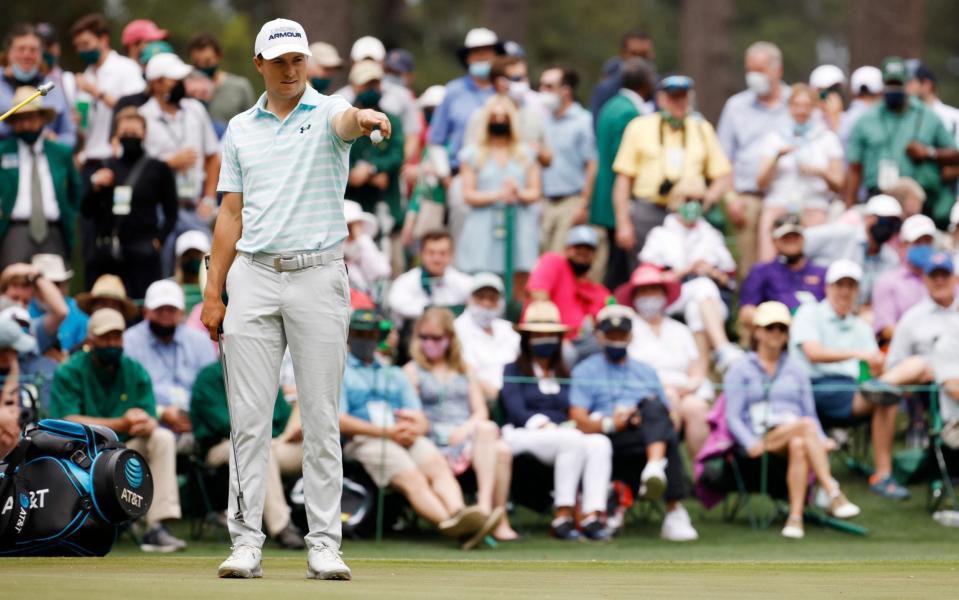The Jordan Spieth swagger of old is back - he now must keep his mind fixed firmly in the present

It felt almost sacrilegious when Gary Murphy, a Sky Sports pundit, drew a parallel earlier this year between Jordan Spieth and Seve Ballesteros. “A bit like Seve, he defies logic,” the Irishman argued. “A vulnerable genius.”
Besides the fact that they have both held the rare distinction of winning the Masters before the age of 25, and that they have both endured grisly acquaintances with Augusta’s water hazards, the two would hardly be anybody’s first choice as kindred spirits. Where Spieth grew up in suburban comfort in Dallas, his Spanish forbear was shaped by a background of rural penury in Pedrena. And yet on Saturday night, from deep in the pine straw beside the eighth green, the 2015 champion conjured a flourish that was unmistakeably Seve-esque.
Jordan Spieth escapes from trouble at hole No. 8 and goes on to make birdie. #themasters pic.twitter.com/ubNOtSc6Dl
— The Masters (@TheMasters) April 10, 2021
Amid the loblollies and the bushes, Spieth spotted a solution invisible to all but him, pitching the ball close to the flag and then using the bank behind to bring it within four feet of the cup. He might not have the lustrous hair of Ballesteros, or the effortless charisma, but he has a golfing brain worthy of the comparison. The fact that he produced such a masterstroke just minutes after double-bogeying the seventh also spoke of a resilience far beyond his 27 years.
Throughout this week at Augusta, the Spieth swagger of old has returned. He has had his setbacks on the course, but never allowed them to snowball. He has watched rivals of the calibre of Dustin Johnson and Brooks Koepka fail even to make the cut, but never lost his belief that his subtle knowledge of the Masters’ vagaries would see him through. Even as Hideki Matsuyama made his back-nine tear to set the standard for everyone else, Spieth retained composure, with a rare three at the 10th and a magnificent sweeping second into the 15th setting up a birdie that kept him in touch.
To anybody familiar with Spieth’s feats from 2015 to 2017, his subsequent drift off the radar has been bewildering. All his life, he had carried his status as a prodigy with ease. First, there were his all-conquering years in junior golf, when parents of his peers would withdraw their children from events as soon as they saw his name on the team-sheet, fearing humiliation. Then came a stunning runner’s-up finish on debut at Augusta in 2014, and a wire-to-wire victory 12 months later that matched Tiger Woods’ 18-under total from 1997.
Spieth became only the sixth player in history to win the Masters and US Open in the same year. In 2015, his annus mirabilis, he became the world No 1, harvested over £15 million in prize money, and swept every significant PGA Tour honour. Nothing encapsulated his talents so vividly as his Open triumph at Royal Birkdale in 2017, achieved in spite of a drive at the 13th that sailed so far right it even cleared the equipment vans. If Seve had been celebrated as the “car park champion” at Royal Lytham in 1979, then Spieth was the demon of the Southport dunes.

Anyone marvelling at Spieth’s performance that day would have been laughed out of town if they had predicted it would be his last win anywhere for four years. But it was not until last week’s glory in Texas, a moment he described as “monumental” for his confidence, that the boy wonder was seen again. For 1,351 days in between, he lost his putting touch, his accuracy off the tee, his world ranking, his very sense of self. His decline was an object lesson in how the game could corrode the mental wellbeing of even the most precocious player.
Sometimes, there are suggestions of superstition. At the par-three 12th, the hole where his tilt at retaining the green jacket in 2016 sank without trace, he tossed his ball into the water after making a four in his second round. That is the fascination with Spieth: for all that he can engineer minor miracles out of nothing, the shadow of impending doom is rarely far away. The only certainty is that at Augusta, where his scoring average of 70.46 is the finest in history, he is impossible to discount.
Starting his third round just two adrift of Justin Rose’s lead, Spieth had wanted to launch a Saturday surge, only to be thwarted when the klaxon for stormy weather sounded immediately after his jaw-dropping shot at the eighth. But he remains the type of player who can pounce from the Sunday pack at will. His closing 64 in 2018, when he tried everything he could to reel in Patrick Reed, tied the tournament record for the lowest final record.
The Texan energy at this year’s Masters is powerful, given the remarkable performance of Will Zalatoris, the beanpole-like 24-year-old who has ridden on the coat-tails of the leaders all week. He and Spieth were contemporaries on the Dallas junior circuit, and increasingly a Ryder Cup partnership between the pair is a distinct possibility. On the latest evidence, the combination of Zalatoris’ pure ball-striking and Spieth’s short game could be irresistible.
For now, the task for Zalatoris is to try to become the first debutant to win the Masters since Fuzzy Zoeller in 1979. “I’ve wanted to be here forever,” he reflected. “There’s no reason to feel intimidated now.” As for Spieth, the psychology is more complex. He cannot simply forget the torment of the past. The priority is that somehow, he keeps his hyperactive mind fixed firmly in the present.

